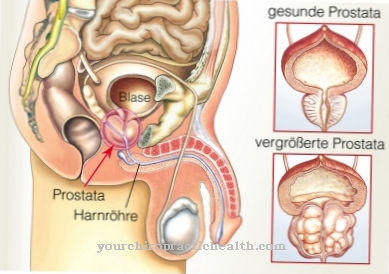Cirrhosis of the liver or Shrinkage of the liver is a chronic progressive disease of the liver. One also speaks of a destruction of the liver which is mostly holistically affected. In particular, the liver lobes are destroyed and converted into connective tissue. Furthermore, liver cirrhosis can be an end-stage of other liver diseases. Men between the ages of 50 and 60 are mostly affected. This disease is less common in women because, statistically, they are less likely to abuse alcohol.
What is cirrhosis of the liver?

© Reing - stock.adobe.com
Cirrhosis of the liver is a disease of the liver. Above all, the vessels and tissue of the liver are permanently destroyed. Liver cirrhosis mainly results in shrinkage of the liver. In addition, the organ behaves to watch. The connective tissue of the liver changes in the course of liver cirrhosis into a scarred structure.
This destruction of the liver, also known as shrink liver, can lead to life-threatening complications. Medically, the liver can be divided into three forms in cirrhosis. There is a large-nodule liver, a small-nodule liver, and a hybrid of the first two. Excessive alcohol consumption often results in a small nodular liver, whereas a large nodular liver is more likely to appear in the case of hepatitis.
causes
At a Cirrhosis of the liver the lobules of the liver become scarred and transformed into connective tissue. This process is called fibrosis. This severely disrupts the functioning of the liver. The liver will now become hard and lumpy. Eventually it finally shrinks. This then results in poor blood flow to the liver, which can lead to portal hypertension. Commonly known causes of liver cirrhosis are:
- Alcohol abuse, 1/2 of all cases
- Hepatitis, B, C, D, 1/4 of all cases
- Disease of the iron, copper or fat metabolism
- Biliary tract diseases with biliary obstruction
- cardiovascular diseases, e.g. Liver congestion in chronic right heart failure
- Poisons or drugs
Cirrhosis of the liver is the result of various liver diseases, which have a wide variety of causes. At over 60 percent, most of all cirrhosis of the liver in Germany can be traced back to alcohol abuse. Cirrhosis of the liver is caused by hepatitis B, hepatitis C or hepatitis D in 20-30 percent of all those affected.
Various hereditary metabolic diseases are among the rarer causes of liver cirrhosis. Tropical diseases, cholera, drugs and chemicals can also be the cause.
Symptoms, ailments & signs
Cirrhosis of the liver can persist for years without noticeable symptoms. With the shrinkage of the liver tissue, the efficiency of the organ decreases, which leads to various complaints. Metabolic disorders usually occur first. Those affected then regularly experience gastrointestinal complaints or develop jaundice.
The blood clotting then deteriorates, which can result in circulatory disorders, pain and cardiovascular problems. The sick liver also has negative effects on the hormonal balance. This can result in hormonal complaints that manifest themselves in the form of mood swings and irritability, but also through physical changes (for example the development of male breasts in women).
In the advanced stages of the disease, symptoms such as fatigue and weight loss also occur. In addition, the sick sweat excessively and suffer from pain in the upper abdomen. The skin is usually gray to yellowish and streaked with visible vascular spiders.
Itching and redness, especially in the area of the heels of the hand, may be noticed. The lacquer lips, i.e. red, smooth and excessively dry lips, are also characteristic. The symptoms progress slowly and can only be reversed with early treatment. However, any organ damage can have long-term consequences and severely impair the patient's quality of life.
Course of disease
The symptoms of Cirrhosis of the liver can also indicate inflammation of the gallbladder or gallstones. Gastritis diseases can also be ruled out. In the further course of liver cirrhosis, liver cancer can also occur, so this disease must also be addressed.
Overall, however, cirrhosis of the liver depends on the cause of the disease. In any case, cirrhosis of the liver should not be treated by yourself, but by a trained doctor. Serious complications can be avoided, especially if the liver cirrhosis is detected in good time. However, once the damage is irreversible, full recovery is no longer possible.
If cirrhosis of the liver remains untreated, there is a high probability that its function will continue to decrease, which can lead to a loss of quality of life or even death. The following complications and damage can occur: water accumulation in the abdomen, metabolic disorders, internal bleeding in the stomach, esophagus or intestines, as well as brain diseases due to insufficient detoxification of the body by the liver.
Complications
Cirrhosis of the liver can cause various complications. Only parts of the liver are detoxified, which in turn has serious effects on the state of health. One of the most common sequelae of liver cirrhosis is hepatic encephalopathy.
Because toxic breakdown products from protein metabolism remain in the blood, the brain is damaged. Initially, the encephalopathy usually remains without symptoms. In the further course, mood swings, concentration problems, prolonged reaction times, sleep-wake rhythm disorders, pathological fatigue and loss of consciousness usually occur. Finally, there is a risk of a hepatic coma.
Ascites is another complication.Fluid accumulates in the abdominal cavity and the sick person suffers from complaints such as breathing problems and abdominal pain. If kidney failure or an infection of the peritoneum (peritonitis) occurs, the complications can have life-threatening consequences.
Portal hypertension (portal vein high pressure) is also considered a concern. With this sequela of liver cirrhosis, the blood builds up in front of the scarred area of the liver, which in turn leads to an increase in portal vein pressure. This causes new blood vessels to form, such as varicose veins, which trigger bleeding from hemorrhoids or from esophageal varices in the esophagus. The latter are considered life-threatening.
Liver cirrhosis also increases the risk of liver cancer. People with liver disease resulting from hemochromatosis or chronic hepatitis B are particularly affected.
When should you go to the doctor?
People who consume alcohol regularly over a long period of time are advised to undergo a medical examination. If the person concerned suffers from withdrawal symptoms, internal restlessness or physical pain without the consumption of alcohol, a doctor's visit is necessary. If there is pressure pain in the upper abdomen or below the ribs, a doctor should be consulted. Digestive disorders, weight loss or loss of appetite are signs of an irregularity. A doctor's visit is necessary so that the cause of the symptoms can be determined. If there is increased irritability, mood swings or changes in personality, medical help is needed.
Irregular heartbeat, changes in the appearance of the skin, poor personal hygiene and itching on the skin are all signs of an existing disease. Yellowing of the eyes or skin is an indication of liver disorders. A doctor's visit is necessary so that medical care can take place. Since cirrhosis of the liver can lead to organ failure and thus to the premature death of the person affected, a doctor should be consulted as soon as the first symptoms arise. A doctor should be presented with a drop in normal performance, a feeling of illness or general malaise. A doctor is also required if increased tiredness or sleep disorders occur over several weeks or months.
Treatment & Therapy
First, the cause of a Cirrhosis of the liver examined by the doctor. Mostly these are an increased alcohol consumption or a hepatitis infection. Therefore, these causes must be combated here first. Alcohol or other toxic substances are to be avoided immediately. If you have hepatitis, treat it first. The damage caused by cirrhosis of the liver can no longer be healed.
However, timely treatment can alleviate further complications and discomfort. Depending on the cause, drug therapy, e.g. diuretic drugs or a liver transplant in alcoholic patients.
Outlook & forecast
The prognosis of diagnosed cirrhosis of the liver is poor. It is a disease that leads to irreparable damage to the organ. Doctors place their main focus in treatment on curbing the progression of the disease. In many cases, however, the patient's cooperation is essential. If you are suffering from alcoholism, you can only relieve the symptoms if you completely refrain from consuming alcohol.
Without medical care, the disorder will normally spread and the liver will gradually break down. Spontaneous healing is not to be expected. There are also no alternative healing methods. The functional activity of the liver is significantly disturbed, so that ultimately it comes to an organ failure and thus to a life-threatening condition. In many patients, a single donor organ transplant can improve or relieve cirrhosis of the liver.
Organ transplantation is associated with numerous risks, side effects, and complications. If the surgical procedure goes without any further abnormalities and the new organ is well accepted by the organism, recovery can take place. The person affected is nevertheless dependent on drug treatment for the rest of their life and experiences impairments in coping with everyday life. Nevertheless, with a donor organ he has a prospect of extending his average expected life.
prevention
So far, abstaining from alcohol is the best way to prevent cirrhosis of the liver. A vaccination against hepatitis can also have a preventive effect. Protection against various poisons such as solvents should also be the primary subject of every bowing measure. General hygiene rules can also protect against the causes of liver cirrhosis.
Aftercare
The form in which follow-up treatments are possible for liver cirrhosis depends on the cause that led to the cirrhosis. The damaging influences must be treated and avoided in any case. The severity of the disease is assigned to a certain stage by follow-up examinations. Accordingly, secondary diseases can be read off.
If the liver cirrhosis can be traced back to long-term alcohol abuse, the first most important starting point is lifelong absolute abstinence from alcohol. In addition to chronic hepatitis diseases, taking medication is a sensible, further treatment for autoimmune diseases. However, these drugs cannot reduce cirrhosis of the liver, but only contain it and largely stop the progression.
Thus, the disease always leads to irreversible damage to the liver. In general, all patients with cirrhosis of the liver should abstain from alcohol without restrictions, eat a healthy diet, and do regular physical activity and sporting activities for life. The switch to a healthy diet can only be successful if it is designed for the long term. Strengthening the immune system plays a key role here in order to limit and suppress secondary diseases.
If brain functions are already impaired by the disease, this is due to the proportion of toxins in the blood that the liver can no longer filter due to the damage. Here, a reduction in toxins must take place through drug treatment. If secondary diseases such as ascites occur over time, these must be treated promptly in order to rule out complications as far as possible.
You can do that yourself
Cirrhosis of the liver is a very serious disease that you should never treat yourself. Since the damage to the liver caused by cirrhosis is usually irreversible, a doctor should be consulted immediately if certain symptoms occur. The onset of cirrhosis of the liver can be heralded by a number of different symptoms, but the organ itself does not hurt. Signs can include loss of appetite, nausea, potency problems and jaundice.
Since cirrhosis of the liver is due to excessive alcohol consumption in about half of all cases and to hepatitis that is usually not properly treated or delayed in about 20 percent of cases, the patient can also help to improve his or her own health. As soon as alcohol-related cirrhosis of the liver is diagnosed, the person concerned must immediately stop drinking or at least drastically reduce it. Since the majority of patients are dependent on alcohol, the support of a doctor is usually not enough. It is best for those affected to undergo detox and then begin psychotherapy to avoid relapse. Membership in a self-help group also helps many affected people. Almost every major city and the Internet offer help for alcoholics that are free of charge.
If the cirrhosis of the liver is due to hepatitis, this underlying disease must be treated completely. It is best for the person concerned to follow all of the doctor's instructions. In addition, he can support the therapy through a healthy lifestyle, in particular by avoiding alcohol, cigarettes and fatty foods.
















.jpg)
.jpg)



.jpg)






